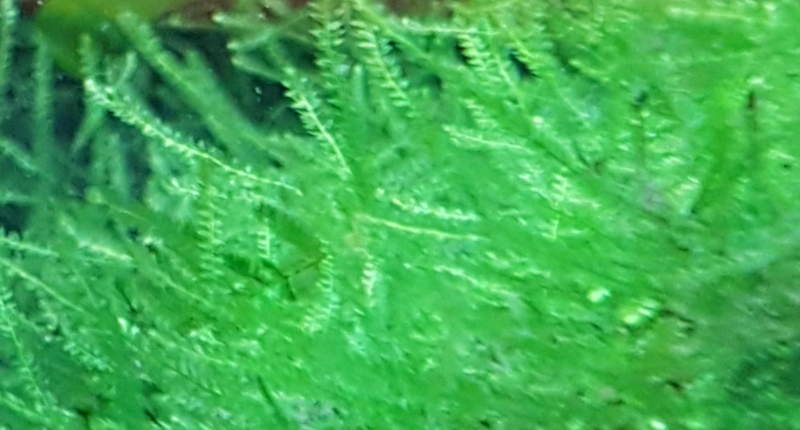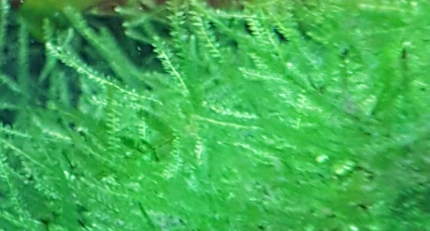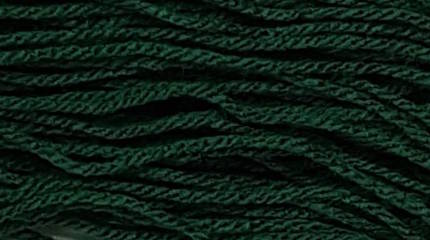Java Moss is one of the easiest aquatic plants to grow and is a great plant for those getting started with live aquarium plants.
It is suitable for most aquariums and provides shelter for fish fry and a home to microorganisms such as infusoria which fry and shrimp can feed on.
Java Moss also has a different appearance to many other aquatic plants and can provide a visual point of difference within your aquarium.
Benefits Of Java Moss
- It is easy to care for and maintain.
- Differs in appearance to many other aquatic plants - so provide a visual point of difference within your aquarium.
- Can be grown if different ways - on driftwood, on rocks, as a carpet, as a bonsai tree.
- Provides hiding places for baby fish and baby shrimp.
- Provides a home to microscopic organisms like infusoria which baby fish and shrimp can feed on.
- Can improve water quality by absorbing nitrates from the water as a nutrient as it grows.

How Java Moss Grows
To grow Java Moss two things are required, good light and good water! Java Moss is almost impossible to kill and in less optimal conditions it tends to just grow more slowly.
Java Moss will grow in low light but higher light will allow it to grow faster providing other requirements are met. More light and more growth also means more pruning and maintenance would be required, so I suggest if you already have at least basic lighting for your aquarium then stick with that as it will be fine for growing Java Moss.
As with all plants Java Moss requires some basic nutrients to grow. It will absorb nutrients from the water as it grows, including nitrate, so Java Moss can help in balancing your aquarium.
Java moss is accepting of a wide range of water conditions and if these are fulfilled you should have no problems in successfully growing Java Moss and keeping it alive.
An important factor to keep in mind for a healthy plant is the water flow. A weak but steady flow is needed to allow fresh water to reach all parts of the moss.
Tip: If you really want your Java Moss to boom and be super healthy you can use a all in one fertiliser to boost macro nutrients (Nitrogen, Phosphorus & Potassium) and micronutrients in your aquarium which will further help plants grow and take up nitrates within the aquarium. Be careful not to over fertilise though as this can promote algae growth. See the using plant fertiliser section below for more details.
Propagating Java Moss
The simplest way to propagate Java Moss is to divide an existing piece into new pieces and then attach those pieces to elsewhere and allow them to grow and become established.
One of the best times to propagate Java Moss is when pruning or maintaining an existing plant. When pruning Java Moss you can remove a clump of moss from the existing plant and replant it or simple place it free floating in another aquarium until you need it.
Once you have an established and healthy Java Moss growing in your aquarium you should be able to propagate from it frequently and never need to buy Java Moss again.
Ways To Plant Java Moss
Java Moss On Driftwood Or Rocks
Java Moss can be attached to driftwood or rock to create a lush green feature within your aquarium.
Java moss can be attached to driftwood or rocks in a few ways:
- By using cotton tread - Simply wrap the cotton thread around both the drift wood and java moss. Within about 1 month the moss would have attached to the wood or rock and the thread can be removed or simply left in place as the moss will grow over the thread and it will no longer be visible. Tip: using dark green cotton thread will.
- Using super glue - Superglue can be used glue Java Moss to driftwood or Rocks. To do this simply put a dob of glue about half inch (or 10mm) wide on to the driftwood or rock then squash a small bunch of Java Moss on to the dob of glue. Let the glue dry so that the moss is stuck to the wood or rock before gently placing the it into the aquarium.
- Wedge between rocks or wood - If your aquascape has a rocks or drift wood placed on top of one another you can simply wedge Java Moss between them. Take a clump of java moss and wedge a portion of it, say half under a piece of driftwood or rack and allow the other half to stick out. This is one of the simplest ways to 'plant' java moss and as long as the water flow is not too strong and the moss stays in position the moss will attach to the wood or rocks within a month or so.
Java Moss Carpet
Java Moss can also be grown as a carpet on the bottom of the aquarium on top of the substrate. The most common way to do this is to sandwich the Java Moss between two metal mesh screens. The mesh screens are heavy enough to hold the Java Moss on place at the bottom of the tank yet allow the moss to stick out and grow through the holes in the mesh.
One thing to note however is that Java Moss kept at the bottom on the aquarium can collect more debris and detritus - see the section below on cleaning dirt and detritus build up.
When most people think of a carpeting plant they imagine the plant growing on the bottom of the aquarium, this is certainly possible. But also keep in mind that a Java Moss carpet can also look great on top of a log or large piece of driftwood which can be place at virtually any level within the aquarium.
Free Floating Java Moss
Java Moss can even be left free floating in an aquarium it will survive ok but won't flourish and will usually grow in a more stringy appearance rather than a dense clump like it does when attached to driftwood.
Free floating Java Moss works best in aquariums with little flow such as those with air driven Sponge or Matten filters. If Java Moss is left to drift in the aquarium it can self attach to driftwood and other hard scape it becomes snagged in, which can either be a good thing or a an annoyance depending on the look you are after in your aquarium. I would not recommend placing free floating Java moss into high flow aquariums especially those using canister filters or sumps as the java moss will likely get caught in the filter intake.
How To Maintain Healthy Java Moss
Cleaning Dirt And Detritus Build Up
As Java Moss usually grows in a dense format it can be prone to trapping detritus and uneaten fish food.
There are two easy ways to clean and remove this dirt build up from your Java moss:
- Remove the moss and the object its growing on from the aquarium and rinse it gently with dechlorinated water or aquarium water from a water change
- When doing a water change lightly siphon the java moss to suck up the dirt and debris. Just be careful and use a weak slow flow when siphoning near the moss so that you do don't suck the moss up or detach it from where it is growing.
Tip: You will find it easiest to remove dirt build up within the moss after it has been pruned. As it will be easier to access the areas where dirt has built up plus there won't be excess moss to get in the way when rinsing or siphoning the moss.
Using Plant Fertiliser
Although not mandatory for growing Java Moss using an all in one plant fertilise can help your Java Moss (and other plants) to grow healthier and faster. It can also assist in managing excess nitrates and reducing algae providing you don't over fertilise.
Plants require nutrients to grow and will consume them from the aquarium. However plants need the right amount of each nutrient and will only consume nutrients up to the point that they need them. If there is a shortage in 1 nutrient this can inhibit plant growth.
If there is too much nitrate for example but not enough of the other required nutrients it can limit the plants growth, as the plant will not consume extra nutrients that it does not need. Therefor you can end up having an unbalanced aquarium with excess nitrates.
Using an all in one aquarium plant fertiliser will boost the level of macro and micro nutrients in the aquarium and thus allow the plants to absorb more nutrients in the ratio it needs to grow, including more nitrates. So in this way a fertiliser will facilitate plant growth and nitrate consumption. Which also mean there is less excess nitrate for algae to feed on.
Removing Algae From Java Moss
Algae can be difficult to remove from Java moss particularly if the algae growth makes its way to the central and dense growth of the moss. But there are a few actions you can take to remedy the issue.
Remove Java Moss That Has Algae
The easiest way to remove algae from java moss is to simply remove the parts of Java Moss which has algae growing on it. This might sounds drastic especially if you only have a small clump of moss but removing a part of the moss which is infested with algae will prevent it spreading more and taking over the entire moss.
After removing the parts of Java moss which have algae growth on them you need to try and address the cause of the algae and look into preventing algae growth in the first place.
Prevent Algae Growth In The First Place
Prevention of algae is the ideal solution, this means limiting excess light and excess nutrients, and maintaining good water quality. If you are starting to see algae growing you can try some of the following steps to reduce algae growth:
Make sure you are doing adequate water changes or increase the water changes you are doing to prevent excess nitrate build up.
Beneficial bacteria in your aquarium filter will break down ammonia to nitrite and then to nitrate which at low levels will not harm your fish.
If you are unsure of your nitrate levels use a water test kit to measure them.
It is unrealistic to aim for 0 nitrates in your aquarium and in a planted aquarium some nitrates are good as they are an important nutrient for plants including Java Moss.
Nitrate levels in the range 20ppm - 40ppm is fine in most planted aquariums. Nitrate levels below 20ppm is fine for fish shrimps and snails but plants will start to suffer with diminishing growth and leaves turning yellow. Nitrate levels should be kept below 100ppm to ensure your fish are healthy.
Reducing the number of hours your aquarium light is on.
Aquarium lighting is also a balancing act, plants require light but excess light in the aquarium can also encourage algae growth.
Around 8 hours of lighting is generally a good starting place for the duration of lighting, so if your aquarium light is on for longer I suggest setting it to 8 hours and monitoring you plant and algae situation.
To ensure consistent light duration use a timer to control how long the light is on.
Getting good plant growth, no algae and a balanced healthy aquarium is a balancing act. It might take a few months to get it right but once you do get it right it will be easier to maintain and look fantastic.
I suggest making gradual changes say a month apart and slowly dialling in to find the sweet spot where you aquarium is flourishing! So for example adjust your lighting then wait a month to evaluate the results, then the following month try adding a small amount of plant fertiliser and evaluating after another month has past.
Conclusion
Java Moss is a unique looking aquarium plant compared to many others. It is versatile and can be grown and used in the aquarium in different ways to create interesting aquascapes.
The best part is that Java Moss is a robust and hardy plant that is easy to care for and almost impossible to kill - which means anyone should be able to successfully grow it in their planted aquarium.


